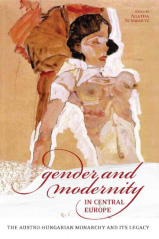October 19th 2010
By Kevin Burns
 Gender and Modernity in Central Europe: The Austro-Hungarian Monarchy and its Legacy, published this year by the University of Ottawa Press, is a collection of essays edited by University of Ottawa professor Agatha Schwartz. In 2008, she, together with Judith Szapor from McGill University, organized an academic conference with the same title that brought together specialists from different areas of study and from universities in Europe, North America, India and Israel. Schwartz was confident that as these scholars shared their insights clear links would emerge between fin-de-siècle Central Europe and contemporary Canada. “There are actually some important lessons that we can learn from Central European Studies that we can also apply in Canada,” she explains.
Gender and Modernity in Central Europe: The Austro-Hungarian Monarchy and its Legacy, published this year by the University of Ottawa Press, is a collection of essays edited by University of Ottawa professor Agatha Schwartz. In 2008, she, together with Judith Szapor from McGill University, organized an academic conference with the same title that brought together specialists from different areas of study and from universities in Europe, North America, India and Israel. Schwartz was confident that as these scholars shared their insights clear links would emerge between fin-de-siècle Central Europe and contemporary Canada. “There are actually some important lessons that we can learn from Central European Studies that we can also apply in Canada,” she explains.
Some of these lessons, says Schwartz, relate to important connections between Central European and Canadian cultures. “Some similarities between Central Europe and Canada are their multiethnic and multicultural aspects: How we can see what kinds of issues arise in communities that are defined by multiculturalism and are composed of different ethnic groups, and what kind of cultural, political, and social issues are involved in those types of communities.”
In Gender and Modernity in Central Europe: The Austro-Hungarian Monarchy and its Legacy, Schwartz has assembled fourteen essays from a wide range of disciplines, including women’s studies, sociology, history, psychology, literature, and visual art. The contributors are specialists in the humanities and social sciences and come from universities and research institutes from cities as various as Budapest, Warsaw, Toronto, Vienna, Victoria, Sheffield, Rhode Island and Ladnun (India), among others.
“Multidisciplinarity defines much of academic work today,” explains Schwartz, “so that working within single disciplinary boundaries is really something passé because people realise we have to look at every issue that we examine from various places and from different aspects.”
Schwartz has organized the collection into five sections. The first looks at the construction of gender and includes Helga Thorson’s essay on the pioneering work of Austrian feminist author Grete Meisel-Hess. Part two examines the Viennese influence on modernity in literature in other parts of the empire, including an essay on the pervasiveness of misogyny in Czech modernist poetry by Marcin Filipowicz. Part three looks at the specific contribution of Jewish women to modernity and includes Michaela Raggam-Blesch’s article on those women who were caught between Anti-Semitism and misogyny in fin-de-siècle Vienna. Given the importance of Vienna in the history of psychoanalysis, Schwartz places the focus of part four on “Viennese modernity and its gender aspects, as well as the spread of psychoanalysis as a new way of treating mental illness to other centres of the empire, is particular, Budapest, and, later, beyond the empire’s borders,” as she explains in her introduction. The final part of the book examines the historical and cultural legacy of Austria-Hungary with contributions from scholars Matthew Stibbe, Tina Bahovec, and Judith Szapor.
The conference a memory and the book now published, Agatha Schwartz’s gender-focused work continues. History, after all, remains unfinished business. She is presently preparing a book that looks into the history and development of women’s movements and women’s writing in the Austro-Hungarian Empire, including the “Czech lands, Slovakia, Slovenia, Croatia, and also the Ukraine, to cast an even wider net,” says Schwartz, “to see what unites them, what differentiates them.” She plans to compare these experiences with those of women “in the Anglo–Saxon context” by also including translations of feminist writings from the same fin-de-siècle period that was her focus in Gender and Modernity.
Gender and Modernity will be officially launched by the University of Ottawa on November 2nd 2010 with The 1956 Hungarian Revolution; Canadian and Hungarian Perspectives (more information on this event soon). For information on how to obtain the book, see the University of Ottawa Press’s website.
